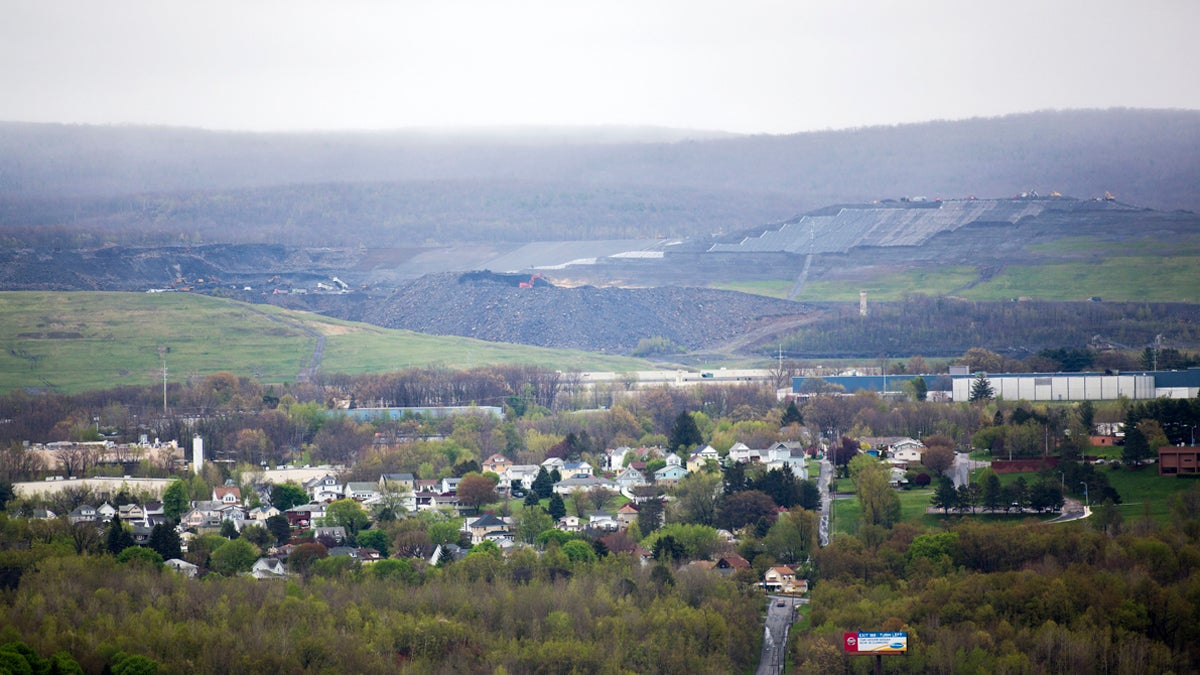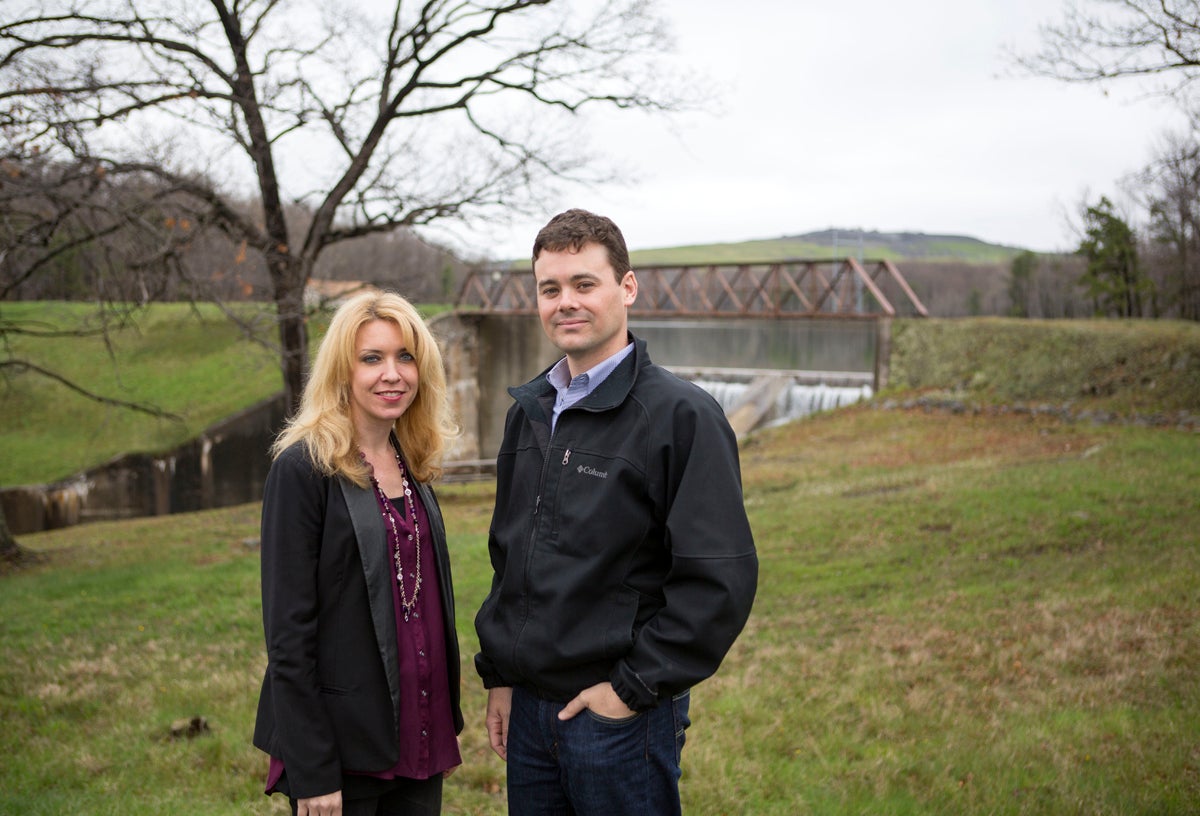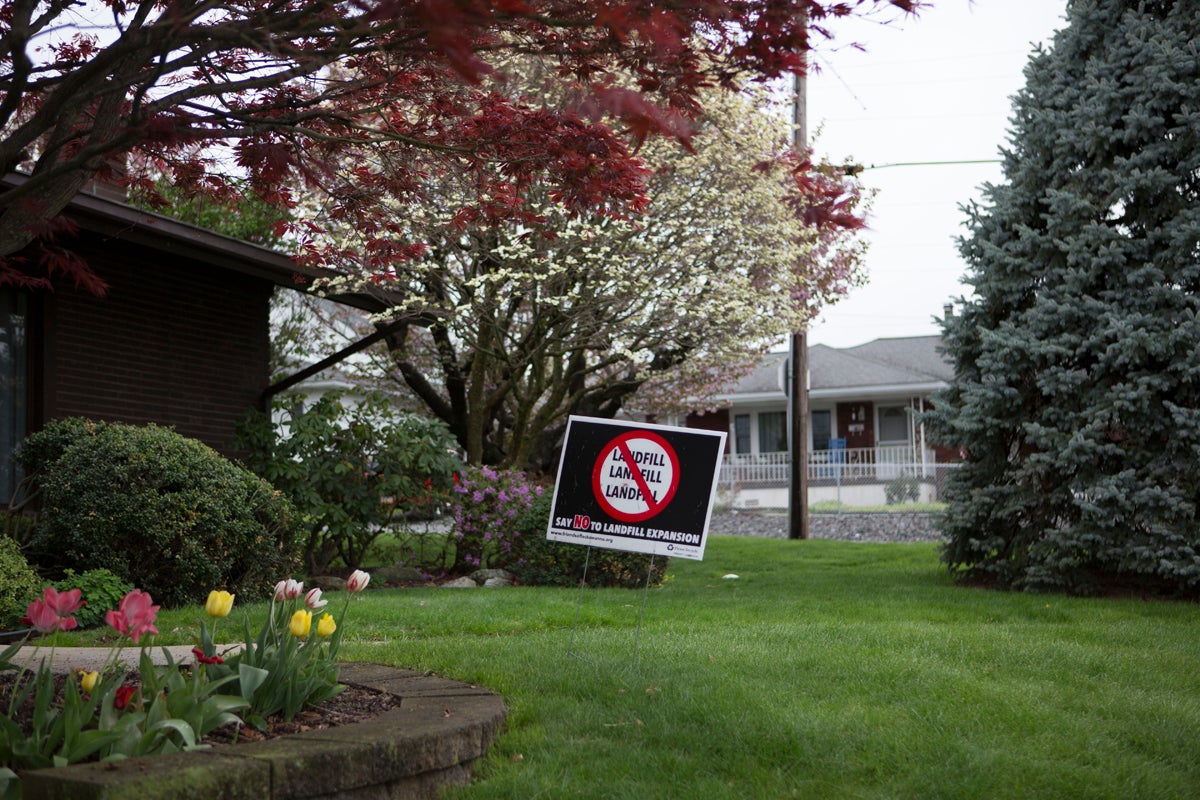Trash talk: Fight over Scranton-area landfill exposes generational divide
Listen
The state's third-largest landfill
The state’s third-largest landfill is hoping for a 40+ year expansion permit.
The Viewmont Mall, in Dickson City, has spectacular views of the Wyoming Valley: rolling green mountains, clusters of neat homes and Scranton’s bustling downtown. But there are a few mountains that look a little different than the others.
“See the sort of messy piles up at the top?” Michele Dempsey is pointing across the valley from her car. “Where it looks, like, black? That’s where the active face is, that is where they are putting garbage.”
Dempsey is talking about the Keystone Sanitary Landfill, a 750-acre operation that accepts 7,250 tons of refuse in 520 heavy trucks each day, much of it from out of state. Dempsey is the founder of a group called Friends of Lackawanna that’s trying to stop the expansion of KSL.
Gone and back again
KSL sits in Dunmore and Throop, two suburbs of Scranton. Dempsey and the landfill grew up together, though she wasn’t aware of it at the time.
She grew up in Swinick’s, a neighborhood of Dunmore that directly abuts KSL. But when she was a kid, the landfill was just that — a landfill, filling in old coal mines. Most people weren’t even aware it existed.
Then, Dempsey, like so many children of Northeast Pennsylvania, left. She moved away for college and further away for work. She was an architect in Philadelphia and D.C. Dunmore and it’s landfill were in the rearview mirror, until she designed a house for her parents back home.
“I came home to see it through construction,” said Dempsey. “And I just ended up falling back in love with home. This is a place that needs bright, talented people to come back and contribute what they’ve learned and help make this area a better place.”
Dempsey opened up an architecture firm in downtown Scranton. In addition to normal assignments, the company has projects like “Scranton What If?” that asked residents to re-imagine derelict spaces and then created a concept design from those dreams. Dempsey organized a convention for fans — and stars — of The Office, the sitcom set in Scranton.
She became a self-described cheerleader for the city, a young voice in an aging town.

Michele Dempsey and Pat Clark of Friends of Lackawanna stand in front of the Dunmore Reservoir. In the distance, you can see the Keystone Sanitary Landfill. (Jessica Kourkounis/For Keystone Crossroads)
Landfill concerns
By the time Dempsey moved back, the coal mines were filled in and the landfill was becoming a trash heap. There are some nuisances that come with living near a landfill, like the smells, the birds and the constant truck traffic.
Back in 2014, Dempsey remembers thinking, “I think there’s less than 10 years left on this permit. Alright, I’m going to grit my teeth, wait [out] the permit. Ten more years, then it’s over, this thing is capped, we’re done.”
But then, KSL applied for an expansion. Originally, the company proposed a vertical expansion, an additional 220 feet in the air. A modified proposal, released Tuesday, says they’d like to keep the landfill’s current height but fill in all the valleys between the four trash mountains, making a single trash plateau over the next 40+ years.
When Dempsey heard the news, her blood ran cold. It wasn’t just the smells or the birds or the traffic.
“Those things are awful and annoying, but not the worst things happening.”
Dempsey is alluding to environmental concerns that can come with landfills, like air pollution and leachate — basically trash juice — leaking into the groundwater. Landfills release gases, like methane, which KSL then burns off with flares. There have been underground fires beneath the landfill, in the mines.
She was also concerned about the effect the landfill would have on economic development in the region. Dempsey began gathering other, equally concerned citizens, like Pat Clark, the owner of a software development company.
“It’s the first thing you see when you drive in off the highway,” said Clark, who, like Dempsey, is a Dunmore native who moved away for school but came back to raise a family. “Think of all the businesses that don’t come here because they’re put off by the idea of locating near a landfill.”
In acknowledgement of the effect on property values, KSL has offered to buy homes located within half a mile of the landfill, if the owners cannot sell them for a price agreed upon by appraisers.
These are young, energetic boosters for a region that could use some boosting. There’s little that Scranton could throw Dempsey’s way that would diminish her love for the area. Pension crisis? Corruption allegations? Underfunded education system? All just opportunities for people to come together, think creatively and problem solve for the future.
But this landfill expansion was different.
“I don’t see any future for the city —” Dempsey modifies herself. “I don’t see any good future for this city if this expansion goes through. I don’t see how we can rebuild on the back of this destructive industry.”

Between homes in a residential neighborhood, you can see the top of the Keystone Sanitary Landfill, a 750-acre operation that accepts 7,250 tons of refuse in 520 heavy trucks each day, much of it from out of state. (Jessica Kourkounis/For Keystone Crossroads)
Green versus green
Al Magnotta, spokesman for KSL, disagrees with that argument. He says the landfill is good for the area and great for the local economy.
“We provide a lot of employment to the area,” said Magnotta. “We provide a lot of assistance to the communities both in charitable [donations] and services. We believe it spins off a lot of business to the local economy that would not exist if it ceased to be there.”
The landfill is a financial boon to the boroughs it occupies. In Throop, $4 million of the borough’s annual $6 million budget comes from host fees paid by the landfill.
Since 1991, Dunmore has received 41 cents per ton of garbage, the state legal minimum in host fees. But in light of the proposed expansion, and thanks to pushback from Friends of Lackawanna, the landfill company renegotiated with the borough. Starting in December 2014, the borough received $1.20 per ton, set to increase by 10 cents per ton each year until 2017. Then, it will increase a penny a year going forward.
KSL also agreed to pay $100,000 to the Dunmore School District each year for 10 years.
The landfill still has about eight years of capacity, so with or without the expansion, Dunmore will reap the benefits of the increased fees. But if the 50-year expansion goes through, the borough would earn nearly $200 million.
That kind of money is hard to say no to, and the Dunmore Borough Council has wavered significantly on the issue. First, in 2014, they wrote a letter of support to KSL, saying they wouldn’t oppose the expansion. Then, they withdrew that letter, saying they needed more time to consider.
Now, five of the seven members have opposed the expansion. But they are still hoping to get the best deal for the borough.
In an interview with the Scranton Times-Tribune, Dunmore Borough Council president Michael McHale said, “The reality is there is a better-than-average chance that it may get passed. So yes, we struggle with that against our personal beliefs.”
Neither McHale, nor the Throop Borough Council President responded to requests for an interview. According to the Times-Tribune, Dunmore city council members who are opposed to the landfill are hesitant to speak out as a group, fearing legal repercussions for the borough.
Powerful owners
Keystone Sanitary is owned by Louis DeNaples, a powerful figure in Scranton. In addition to KSL, DeNaples owns an auto parts company, real estate holdings and numerous other businesses. He owned the Mt. Airy Casino, Northeastern Pennsylvania’s first foray into the slots gambling industry, until legal issues required him to transfer ownership to a family member.
DeNaples was convicted of fraud in 1978 for falsifying records relating to the federal aid provided to Scranton after Hurricane Agnes. He pled no contest and later, a member of the Bufalino crime family was convicted of bribing a juror on the case. DeNaples was never accused in the bribery case.
DeNaples has donated huge sums of money to organizations around the region. Visitors to the University of Scranton are immediately greeted by the state-of-the-art DeNaples Center, and members of the DeNaples family sit on boards across the area. He has donated to political campaigns of all stripes.
“They give a heck of a lot of money away to people and causes and help a lot of people out, I don’t think anyone would dispute that,” said Clark. “It does not give you a blank check to grow your business on the back of this community.”
Requests for an interview with DeNaples were sent to Magnotta.

A resident shows their opposition to the landfill expansion with a lawn sign. Friends of Lackawanna’s cause has been garnering support from not only residents, but from local leaders and Senator Bob Casey. (Jessica Kourkounis/For Keystone Crossroads)
Dempsey and Clark say Friends of Lackawanna’s fight is with the landfill, not the owners. But the ownership is what made the fight much harder in the beginning, when they set out to gather support.
“It has given them insulation from people speaking out, it has given them insulation from people wanting to join our cause with a loud voice,” said Clark.
But that has been changing. A new generation of leaders is emerging and they’d rather not play by the same rules that have governed Scranton for decades. Friends of Lackawanna is at the center of that.
“Friends of Lackawanna tends to be primarily a lot of people who moved back to the area and are raising young families and have started businesses and chose to be back here because we love it,” said Dempsey. “We don’t feel anyone has the right to do what’s happening here.”
Their cause is gaining momentum. A recent event had 600 attendees, and local government leaders are opposing the expansion as well.
Even Senator Bob Casey, who is from the area, has spoken out against the landfill. Casey has also proposed national legislation that would slow the flow of garbage into Pennsylvania, the nation’s largest importer of trash.
Ultimately, the decision lies in the hands of the DEP. Ken Reisinger, deputy secretary for waste, says the agency will do a thorough review of the application.
“We base our decisions on science,” said Reisinger. “So just because someone doesn’t like something, doesn’t give us enough to deny an application where a landfill would have satisfied all the permit requirements.”
Newcomers, old-timers and everyone in between await that decision.
WHYY is your source for fact-based, in-depth journalism and information. As a nonprofit organization, we rely on financial support from readers like you. Please give today.


